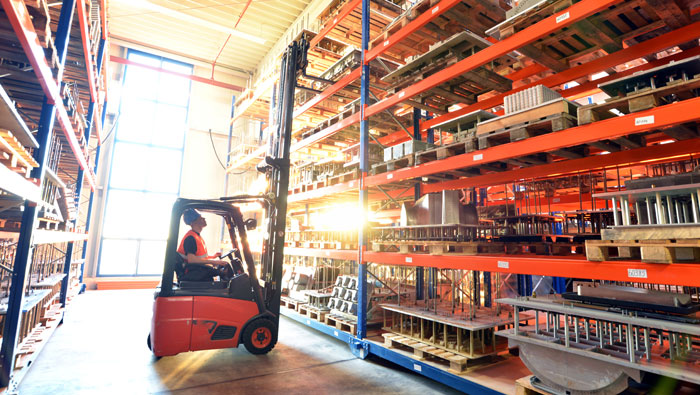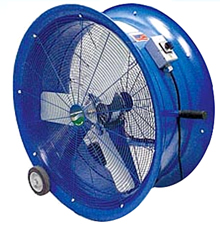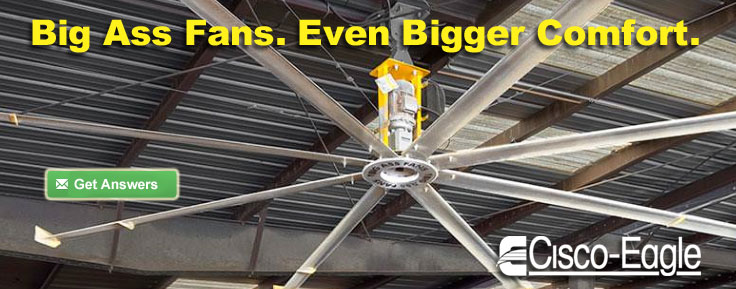What to Do When You Can’t Air Condition Your Warehouse
Alternatives for employee comfort in the heat

If you run a warehouse, you’re keenly aware of how hot and uncomfortable it can get on a scorching July afternoon—and you also know how much that affects your workforce, their comfort, their error rates and their ability to get things done. Installing air conditioning may not be feasible for every industrial facility, but there are alternatives.
Factors for warehouse air conditioning
In some cases, it’s either practically or economically impossible to install air conditioning. These situations include the following:
- If the facility isn’t insulated, and proper insulation isn’t possible
- If there are large dock doors that must be frequently opened, or stay constantly open
- If the facility is an area like an open-sided depot where cooled air can’t be contained
- If the warehouse is large but sparsely populated, and HVAC isn’t justifiable
- When the dehydrating effects of air conditioning are an issue
- If the facility isn’t operable for large portions of the year, meaning the capital investment is too large for a sustainable return-on-investment
- Anytime you cannot afford the costs of air conditioning—when these costs are extremely high and judged to be impossible in terms of ROI
All of these are valid reasons, but you are still left with the problem of a hot building, which can pose safety, retention, quality and error issues.
We cover these numbers in depth in this blog post:
How Heat Saps Warehouse Productivity, Causes Errors and Reduces Retention
What can you do to increase comfort if HVAC isn’t possible?
What methods can you use when air conditioning isn’t feasible? Most involve moving air with alternative methods, but not all. You can segment parts of the facility off from others, bring in natural air and use other methods to cool the facility.
HVLS warehouse fans
Where directional fans work to increase comfort in a specific area, HVLS fans are used to address large portions of space, or even an entire facility. They do not blow directly on workers. Instead, they help make a larger area of the the plant more comfortable. The accepted average is around a ten-degree perceived temperature reduction.
A single fan can create a cooling effect up to 20,000 square feet, and is an economical method to increase comfort in facilities that can’t sustain HVAC.
Directional fans
 In some situations, directional fans will drive comfort in a hot facility. You can install directional fans on columns, bases, etc. They are good for cooling a specific person or area, and come in a variety of sizes and configurations. Many of these fans can be installed in areas like rack tunnels that are hard to reach and cool, or in tight spaces where floor fans can’t be used.
In some situations, directional fans will drive comfort in a hot facility. You can install directional fans on columns, bases, etc. They are good for cooling a specific person or area, and come in a variety of sizes and configurations. Many of these fans can be installed in areas like rack tunnels that are hard to reach and cool, or in tight spaces where floor fans can’t be used.
- Evaporative coolers provide a cooling mist in areas where it’s feasible, and are particularly useful for outdoor applications, break areas and other places where work in process isn’t affected by the mist.
- Truck & dock fans move massive amounts of air at high speeds, increasing comfort levels on hot summer days. These can be mounted on arms to cool the interior of truck trailers.
More methods to reduce heat
- Keep the dock doors open: When you can’t air condition, a breeze from outside can be enormously helpful, even on hot days. This can create issues with airborne debris and dust, which affects paint lines, processing, inventory and overall facility cleanliness. Another concern may be insects, rodents and other pests. You can reduce insects and debris by installing overhead mesh doors that allow air flow, but block flying insects and some level of airborne debris. There are also screen doors that function similarly.
- Segment off heat sources: If possible, you can segment off heat-generating equipment with insulated curtains so it doesn’t raise the temperatures throughout the facility.
- Utilize portable air conditioners: If HVAC throughout an entire facility isn’t possible, consider portable units. You can rent these for the summer and use them to target specific areas of the operation.
- Deploy an evening shift: Obviously this isn’t feasible for all operations, but when you can do it, it’s a cooler situation for everyone involved.
Be prepared
When you have hot work in an enclosed space, you should take extra care to ensure you have adequate resources for workers. This includes processes to handle heat-related incidents like heat exhaustion, as well as medical supplies and training. Frequent breaks and plentiful water within easy reach are mandatory.
Make sure procedures are in place and medical supplies are on hand for dealing with employees who faint or display other heat-related symptoms.
Final thoughts
Aside from risks like heat exhaustion and overall diminished safety, efforts to cool a hot facility can result in better productivity, lower turnover rates and improved accuracy. Also, consider your high-skill, aging workers who cannot endure heat the way younger ones can. Providing them with a better environment is an ideal way to extend their careers and create lasting value.
Tags: ROI
Scott Stone is Cisco-Eagle's Vice President of Marketing with more than thirty years of experience in material handling, warehousing and industrial operations. His work is published in multiple industry journals an websites on a variety of warehousing topics. He writes about automation, warehousing, safety, manufacturing and other areas of concern for industrial operations and those who operate them.




